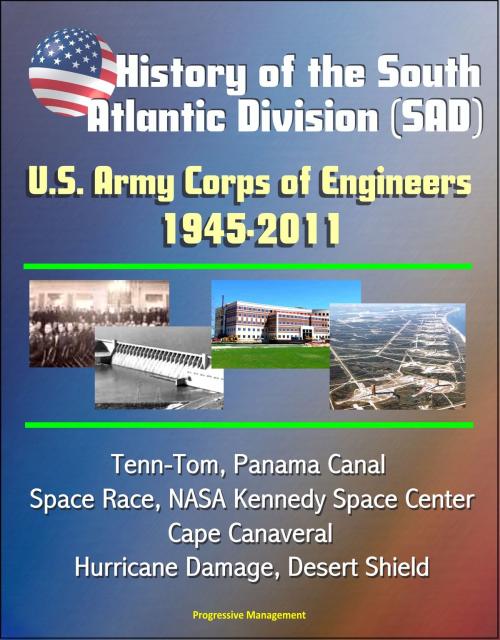History of the South Atlantic Division (SAD) U.S. Army Corps of Engineers, 1945-2011 - Tenn-Tom, Panama Canal, Space Race, NASA Kennedy Space Center, Cape Canaveral, Hurricane Damage, Desert Shield
Nonfiction, Science & Nature, Technology, Engineering, Civil, Aeronautics & Astronautics| Author: | Progressive Management | ISBN: | 9781311955074 |
| Publisher: | Progressive Management | Publication: | September 21, 2014 |
| Imprint: | Smashwords Edition | Language: | English |
| Author: | Progressive Management |
| ISBN: | 9781311955074 |
| Publisher: | Progressive Management |
| Publication: | September 21, 2014 |
| Imprint: | Smashwords Edition |
| Language: | English |
The U.S. Army Corps of Engineers South Atlantic Division was formally established in 1929 with headquarters in Richmond, Virginia, but Corps of Engineers service to the southeastern United States extends back to the founding of the nation. This history covers the modern period, from the end of World War II to the end of 2010.
This period has been an extremely active one for the South Atlantic Division. It was legislation passed after the war that jump-started the rapid growth and modernization of the southeastern region. The massive multiple-purpose reservoirs that provide hydropower, flood risk reduction, navigation, water supply and recreation to the people of the region were built in the 1950s and '60s, and contributed significantly to the economic development of the southeast. At the same time, the South Atlantic Division was providing design, construction, and real estate support to the high concentration of military facilities in the region.
During the space race, SAD oversaw the construction of four important installations. Construction projects at these facilities were engineering marvels. SAD engineers oversaw and supervised their funding, design, contracting, and construction. At Kennedy, SAD engineers assisted in the designing and construction of the first launch facilities. NASA and the Air Force were able to rely on the Corps' expertise in civil works as well as military construction as they created new installations. Additionally, SAD developed a skilled staff and relationships with many specialized engineering firms that could assist in the design and construction of the aerospace infrastructure. Although SAD did not build any of the rockets or spacecraft or train the astronauts, its managing of the construction projects was, and is, an essential part of the nation's very successful space program. The expertise of the Corps and its ability to provide flexible and skilled results assisted in the nation realizing President Kennedy's goal of landing on the moon by the end of the 1960s.
FOREWORD * CHAPTER 1 - THE BIG PICTURE * OVERVIEW OF THE ORGANIZATION OF THE CORPS OF ENGINEERS AND SAD * PREVIOUS HISTORIES OF SAD * METHODS * THEMES FOR THIS HISTORY * NEED FOR FUTURE WORK * CHAPTER 2 - BEGINNINGS: SOUTH ATLANTIC DIVISION PRIOR TO 1945 * THE SOUTHEAST DIVISION 1888-1929 * 1929-1945: THE SOUTH ATLANTIC DIVISION IS FORMED, FACES THE DEPRESSION AND SUPPORTS THE WAR EFFORT * CHAPTER 3 - THE WAR IS OVER! NEW MISSIONS, NEW APPROACHES * NEW MISSIONS ARE DEFINED * SAD'S MANAGEMENT APPROACHES * BALANCING THE WORK, BALANCING THE DISTRICTS * CHAPTER 4 - SAD SUPPORTS THE COLD WAR MILITARY * SAD KOREAN WAR CONSTRUCTION * THE 1950S * THE 1960S AND THE VIETNAM WAR * CHAPTER 5 - SAD AND THE RACE FOR SPACE * ARNOLD ENGINEERING DEVELOPMENT CENTER * REDSTONE/MARSHALL SPACE FLIGHT CENTER * THE MISSISSIPPI TEST FACILITY * KENNEDY SPACE CENTER AND CAPE CANAVERAL AIR STATION * SUPPORTING MILITARY SPACE * CHAPTER 6 - THE END OF THE COLD WAR AND OPERATIONS IN THE MIDDLE EAST: MILITARY CONSTRUCTION IN SAD SINCE 1973 * SAVANNAH AND MOBILE DISTRICT WORK IN THE MODERN ARMY PERIOD * SAD WORK IN CENTRAL AMERICA IN THE 1980S * PROJECT MANAGEMENT AND THE J-6 LARGE ROCKET TEST FACILITY AT TULLAHOMA * MEAPO AND CONSTRUCTION FOR AMERICA'S ARAB ALLIES * MAKING WAY FOR THE MODERN MILITARY: BRAC AND MILCON TRANSFORMATION * TRAINING CENTERS * HEALTH CARE FACILITIES * AIR FORCE WORK * CHAPTER 7 - HARBOR AND NAVIGATION PROJECTS IN THE POST WAR PERIOD * THE CROSS FLORIDA BARGE CANAL * THE TENNESSEE-TOMBIGBEE WATERWAY * THE COOPER RIVER REDIVERSION CANAL * UNDOING WHAT IT ONCE DID?
The U.S. Army Corps of Engineers South Atlantic Division was formally established in 1929 with headquarters in Richmond, Virginia, but Corps of Engineers service to the southeastern United States extends back to the founding of the nation. This history covers the modern period, from the end of World War II to the end of 2010.
This period has been an extremely active one for the South Atlantic Division. It was legislation passed after the war that jump-started the rapid growth and modernization of the southeastern region. The massive multiple-purpose reservoirs that provide hydropower, flood risk reduction, navigation, water supply and recreation to the people of the region were built in the 1950s and '60s, and contributed significantly to the economic development of the southeast. At the same time, the South Atlantic Division was providing design, construction, and real estate support to the high concentration of military facilities in the region.
During the space race, SAD oversaw the construction of four important installations. Construction projects at these facilities were engineering marvels. SAD engineers oversaw and supervised their funding, design, contracting, and construction. At Kennedy, SAD engineers assisted in the designing and construction of the first launch facilities. NASA and the Air Force were able to rely on the Corps' expertise in civil works as well as military construction as they created new installations. Additionally, SAD developed a skilled staff and relationships with many specialized engineering firms that could assist in the design and construction of the aerospace infrastructure. Although SAD did not build any of the rockets or spacecraft or train the astronauts, its managing of the construction projects was, and is, an essential part of the nation's very successful space program. The expertise of the Corps and its ability to provide flexible and skilled results assisted in the nation realizing President Kennedy's goal of landing on the moon by the end of the 1960s.
FOREWORD * CHAPTER 1 - THE BIG PICTURE * OVERVIEW OF THE ORGANIZATION OF THE CORPS OF ENGINEERS AND SAD * PREVIOUS HISTORIES OF SAD * METHODS * THEMES FOR THIS HISTORY * NEED FOR FUTURE WORK * CHAPTER 2 - BEGINNINGS: SOUTH ATLANTIC DIVISION PRIOR TO 1945 * THE SOUTHEAST DIVISION 1888-1929 * 1929-1945: THE SOUTH ATLANTIC DIVISION IS FORMED, FACES THE DEPRESSION AND SUPPORTS THE WAR EFFORT * CHAPTER 3 - THE WAR IS OVER! NEW MISSIONS, NEW APPROACHES * NEW MISSIONS ARE DEFINED * SAD'S MANAGEMENT APPROACHES * BALANCING THE WORK, BALANCING THE DISTRICTS * CHAPTER 4 - SAD SUPPORTS THE COLD WAR MILITARY * SAD KOREAN WAR CONSTRUCTION * THE 1950S * THE 1960S AND THE VIETNAM WAR * CHAPTER 5 - SAD AND THE RACE FOR SPACE * ARNOLD ENGINEERING DEVELOPMENT CENTER * REDSTONE/MARSHALL SPACE FLIGHT CENTER * THE MISSISSIPPI TEST FACILITY * KENNEDY SPACE CENTER AND CAPE CANAVERAL AIR STATION * SUPPORTING MILITARY SPACE * CHAPTER 6 - THE END OF THE COLD WAR AND OPERATIONS IN THE MIDDLE EAST: MILITARY CONSTRUCTION IN SAD SINCE 1973 * SAVANNAH AND MOBILE DISTRICT WORK IN THE MODERN ARMY PERIOD * SAD WORK IN CENTRAL AMERICA IN THE 1980S * PROJECT MANAGEMENT AND THE J-6 LARGE ROCKET TEST FACILITY AT TULLAHOMA * MEAPO AND CONSTRUCTION FOR AMERICA'S ARAB ALLIES * MAKING WAY FOR THE MODERN MILITARY: BRAC AND MILCON TRANSFORMATION * TRAINING CENTERS * HEALTH CARE FACILITIES * AIR FORCE WORK * CHAPTER 7 - HARBOR AND NAVIGATION PROJECTS IN THE POST WAR PERIOD * THE CROSS FLORIDA BARGE CANAL * THE TENNESSEE-TOMBIGBEE WATERWAY * THE COOPER RIVER REDIVERSION CANAL * UNDOING WHAT IT ONCE DID?















